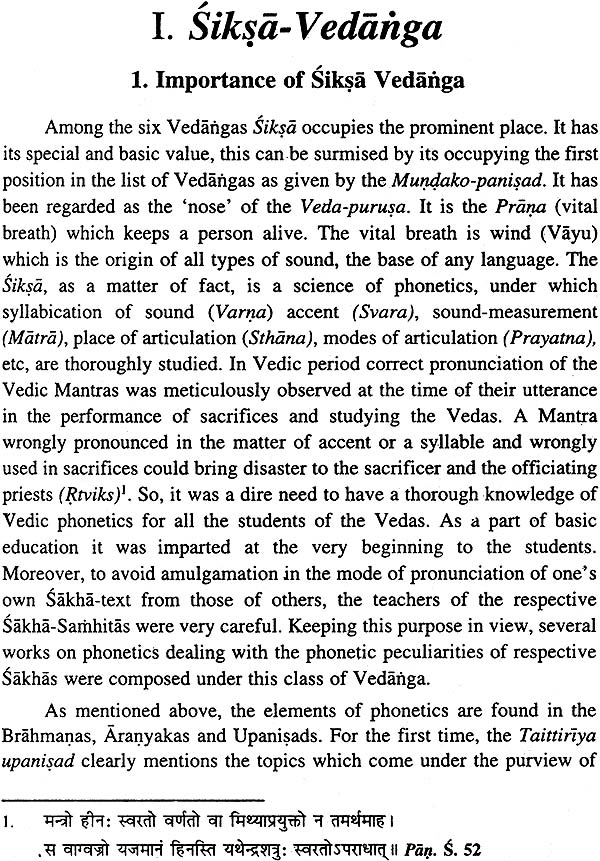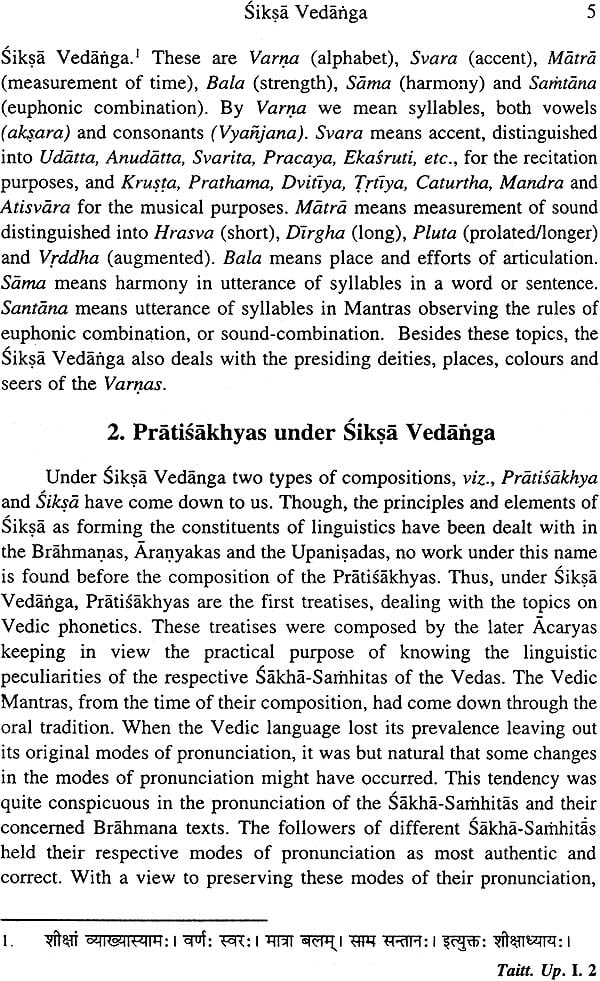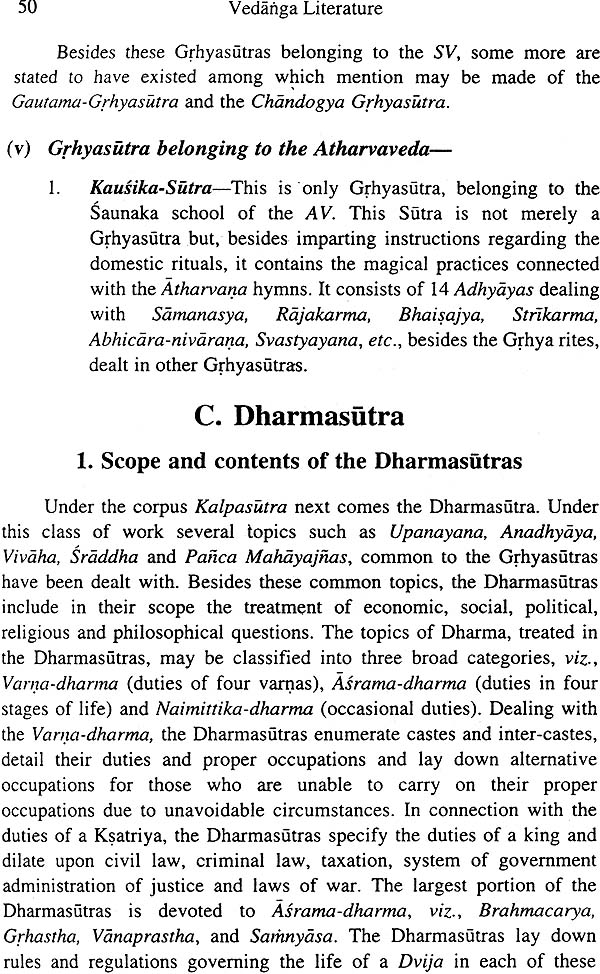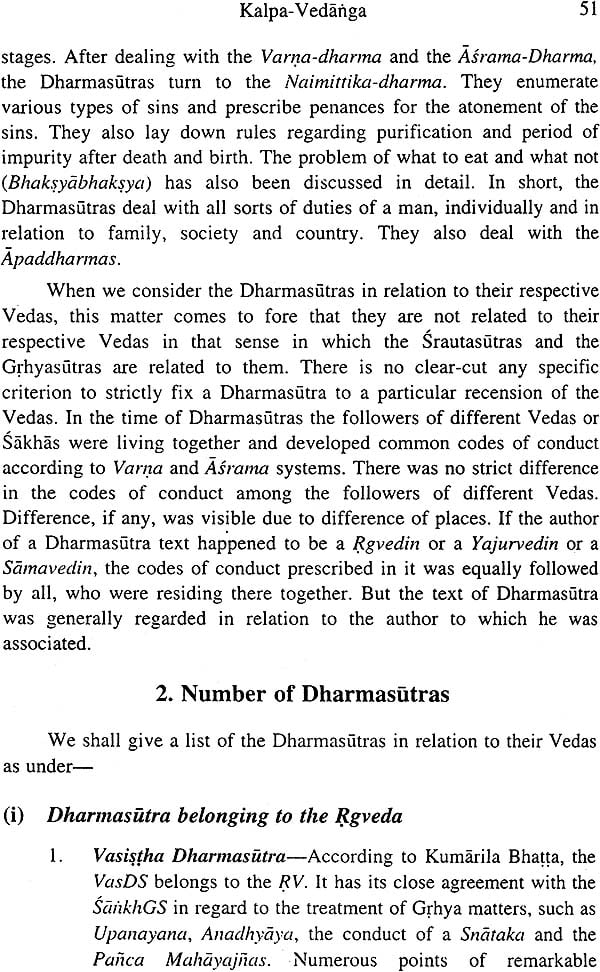
Vedanga Literature (Auxiliary to the Vedas)
Book Specification
| Item Code: | NAC051 |
| Author: | Prof. B.B. Chaubey |
| Publisher: | KATYAYAN VAIDIK SAHITYA PRAKASHAN |
| Language: | English |
| Edition: | 2004 |
| Pages: | 70 |
| Cover: | Paperback |
| Other Details | 8.5 inch X 5.5 inch |
| Weight | 90 gm |
Book Description
Veda, comprising of both the Samhitas and the Brahmanas, is the most ancient literature of the world. Traditionally, it is expected that they should be studied with the help of the Vedangas, omprising Sika, Vyakarana, Nirukta, Chandas, Kalpa and Jyotisa. A large number of texts, dealing with-each Vedanga, have been composed by the post Vedic Acaryas. How these six Vedangas render their help to understand the Vedas and how many texts dealing with Vedangas are now available to us, must be known to a student of Veda. This small booklet has' been written with a view to presenting, in brief, an account of all the six Vedangas along with the topics dealt with therein to make a common English-knowing person to have a knowledge of this genre of Vedic literature. I do hope, this book will serve their purpose well.
Introduction
Veda is the most ancient literature of the world. It has come to us under two forms, viz, Mantra and Brãhmana. The Mantras were revealed to the seers in their intition in their state of penance and which were later collected and compiled in the form of four Sãmhitãs, viz, Rgveda (RV), Yajurveda (YV), Samaveda (SV) and Atharvaveda (AV). Again these four Samhitãs were handed down in several recensions (Sakhas) with growth of time. By the time of Patanjali there were, at least, 21 recensions of the RV, 101 recensions of the YV, one thousand recensions of the SV and 9 recensions of the AV. The entire Mantra-literature, preserved in the four Samhitas or in their different recensions, thus, formed the first corpus of the Vedic literature. The second form of Vedic literature, called Brahmana, was of the commentatorial nature, as it has come into existence with a view to explaining the secret purports of Mantras by the Brahmavadins, who had received the knowledge of Vedic Mantras through Upadesa (proclamation) of the ancient seers in their oral tradition. With the development of time there came a stage when the secret purports of the Mantras could not be understood by the later generations of the Brahmavadins by mere Upadesa. Therefore, a third particular type of literature, called Vedanga, was composed by the particular type of literature, called Vedanga, was composed by the Acaryas based on the lines of their predecessor Brahmavadins, by which both types of literature, viz, Mantra and Brahmana could be understood by the persons of common intelligence.!
The world Vedanga connotes a particular type or class of literature which rendered a great help to the understanding of the Vedas, comprising both Mantra and Brahmana. As such Vedanga is an auxiliary type of literature. There are six things which are most essentially required for understanding the Vedas. The first and foremost thing for studying the Veda is phonetics. Without having knowledge of Vedic phonetics no body can utter the Mantras. Therefore, the class of literature which deals with Vedic phonetics is called Siksã. Another class of literature which helps to understand the nature of Vedic language by dealing with its various elements, such as Nãma, Akhyãta, Upasarga and Nipãta and prescribing rules for their correct uses, is called Vyãkaraza. The entire Mantra-literature is found in either verse, or prose or song form which are technically known as Rk, Yajus and Sãman, respectively. To impart correct knowledge of these metrical compositions a special class of literature, called Chandas, was composed by the Acaryas. This class of literature deals with the metrical rules of the Vedic compositions. Without having proper knowledge of the metrical rules, Vedic Mantras could not be recited correctly. After a considerable interval of time from the time of their compositions, it had become most difficult to know the correct form of the Vedic vocables, particularly, when the old Vedic Vocables had lost their meanings in the later period. How the Vedic Mantras could be interpreted by tracing the roots of the Vedic words, for this a new type of literature, called Nirukta, was composed. All possible principles of Vedic interpretation were formulised by the authors of the Niruktas. This Vedanga was directly connected with the problems of Vedic interpretation.
In the time of the Brahmanas the science of scarifice had developed to a considerable extent, and the Vedic Mantras had begun to be employed in the performances of Vedic rituals. No doubt, the Brãhmanas had laid down certain principles of employing the Mantras in different rituals and had discussed in detail about each and every subtle thing related to the rituals highlighting their Adhyãtmika, Adhidaivika, ritualistic and symbolic significance, a particular class of work which could give a systematic account of Vedic rituals for the purpose of not only their performances, but for observing the code of conduct from birth to death for the people in their whole span of life, was a most essential need. This need was fulfilled by the composition of the Kalpasutras. This class of literature helped very much to understand the observance of the code of conduct in the life of a person following the path of the Vedic Dharma. It is pertinent to note that the rituals, performed by a householder throughout his life, were not arbitrarily performed at any time. Each Srauta or domestic rite was performed on an auspicious occasion. The knowledge of auspicious and appropriate time is most essential for successful performance of a specific ritual. A class of literature, called Jyotisa, dealing with both astronomy and astrology, was composed by the Acaryas of the period. This class of literature helped in determining the proper positions of the stats or the Naksatras, the Ayanas, Rtus, months and Ahotratra, for the performance of the rituals whether Srauta or domestic. Thus, the six classes of works, viz., Siksa, Vyakarana, Chandas, Nirukta, Kalpa and Jyotisa are traditionally regarded as Vedangas. Their knowledge was essential for understanding the Vedas and the Vedic ways of life. These Vedangas have also been regarded as six limbs of the Veda-Purdusa. Chandas (Metre) is said to be the two feet, Kalpa as the two hands, Jyotisa as the eye, Nirukta as the ear, Siksa as the nose, and Vyakarana as the mouth. A person having learnt the Vedas with these Angas (limbs) is celebrated in the Brahmaloka.
The Vedangas have their ample source in the Brahmanas regarding their subject-matter. These topics have been dealt with throughout the Brahmana-literature, but without being referred to under these appellations. The Sadvimsa Brahmana refers to the six Vedangas but does not supply the list of their names. It is the Mandukyopanisad which, for the first time, supplies the list. Now we shall deal with individual Vedangas in some detail.
| Preface | 1-3 | |
| I | Siksa Vedanga | 4-16 |
| 1. | Importance of Siksa Vedanga | 4 |
| 2. | Pratisakhyas under Siksa Vedanga | 5 |
| 3. | Number of Pratisakhyas | 6 |
| A. Pratisakhyas related to the Rgveda | 6 | |
| (i) Rgveda Pratisakhya | 6 | |
| B. Pratisakhyas related to the Yajurveda | 7 | |
| (i) Vajasaneyi Pratisakhya | 7 | |
| (ii) Bhasika-Sutra | 7 | |
| (iii) Taittiriya Pratisakhya | 7 | |
| C. Pratisakhyas related to the Samaveda | 8 | |
| (i) Rktantra | 8 | |
| (ii) Samatantra | 8 | |
| (iii) Aksaratantra | 8 | |
| (iv) Puspasutra | 8 | |
| (v) Stobhanusamhara | 8 | |
| D. Pratisakhyas related to the Atharvaveda | 10 | |
| (i) Atharvaveda Pratisakhya | 10 | |
| (ii) Caturadhyayika | 10 | |
| 4. | Number of Siksas | 11 |
| A. Siksas related to the RV | 11 | |
| B. Siksas related to the SV | 12 | |
| C. Siksas related to the Sukla YV | 13 | |
| D. Siksa related to the Krsnayajurveda | 15 | |
| E. Siksa related to the AV | 16 | |
| II | Vyakarana - Vedanga | 17-21 |
| 1. | Ingredients of Vyakarana | 17 |
| 2. | Purpose of Studying Vyakarana | 18 |
| 3. | Works on Vyakarana | 21 |
| III. | Nirukta-Vedanga | 22-29 |
| 1. | Nomenclature | 22 |
| 2. | Nirukta as a science of etymology | 23 |
| 3. | Principles of Etymology | 24 |
| 4. | Classification of Yaska’s etymologies | 26 |
| 5. | Importance of Nirukta | 26 |
| 6. | Contents of Nirukta | 28 |
| IV. | Chandas - Vedanga | 30-34 |
| 1. | Importance of Chandas | 30 |
| 2. | Texts dealing with chandas | 31 |
| (i) Rgveda-Pratisakhya (Chandas Patalas) | 31 | |
| (ii) Chandahsutra | 34 | |
| (iii) Chandovicitih | 34 | |
| V. | Kalpa - Vedanga | 35-56 |
| 1. | Importance of Kalpa | 35 |
| 2. | Fourfold division of Kalpa | 35 |
| A. Srautasutra | 3-44 | |
| 1. Scope and contents of the Srautasutras | 36 | |
| 2. Number of the Srautasutras | 38 | |
| (i) Srautasutras related to the Rgveda | 39 | |
| 1. Sankhayana Srautasutra | 39 | |
| 2. Asvalayana Srautasutra | 39 | |
| (ii) Srautasutras related to the Krsna Yajurveda | 39 | |
| 1. Vadhula Srautasutra | 39 | |
| 2. Baudhayana Srautasutra | 40 | |
| 3. Bharadvaja Srautasutra | 40 | |
| 4. Apastamba Srautasutra | 40 | |
| 5. Manava Srautasutra | 40 | |
| 6. Varaha Srautasutra | 41 | |
| 7. Satyasadha-Hiranyakesi Srautasutra | 41 | |
| 8. Vaikhanasa Srautasutra | 41 | |
| 9. Kathaka Srautasutra Sankalanam | 41 | |
| (iii) Srautasutra belonging to the Sukla Yajurveda | 42 | |
| 1. Katyayana Srautasutra | 42 | |
| (iv) Srautasutras belonging to the Samaveda | 42 | |
| 1. Arseya Kalpa | 42 | |
| 2. Ksudra Kalpasutra | 42 | |
| 3. Latyayana Srautasutra | 43 | |
| 4. Drahyayana Srautasutra | 43 | |
| 5. Jaiminiya Srautasutra | 43 | |
| 6. Nidana-Sutra | 44 | |
| (v) Srautasutra related to the Atharvaveda | 44 | |
| 1. Vaitana Sutra | 44 | |
| B. | Grhyasutra | 44-50 |
| 1. Scope and contents of Grhyasutras | 44 | |
| 2. Number of Grhyasutras | 45 | |
| (i) Grhyasutras related to the RV | 46 | |
| 1. Sankhayana Grhyasutra | 46 | |
| 2. Kausitaki Grhyasutra | 46 | |
| 3. Asvalayana Grhyasutra | 46 | |
| (ii) Grhyasutras belonging to the Krisna YV | 46 | |
| 1. Baudhayana Grhyasutra | 46 | |
| 2. Bharadvaja Grhyasutra | 47 | |
| 3. Apastamba Grhyasutra | 47 | |
| 4. Satyasadha Hiranyakesi Grhyasutra | 47 | |
| 5. Manava Grhyasutra | 47 | |
| 6. Vaikhanasa Grhyasutra | 47 | |
| 7. Agnivesya Grhyasutra | 48 | |
| 8. Kathaka Grhyasutra | 48 | |
| 9. Varaha Grhyasutra | 48 | |
| 10. Vadhula Grhyasutra | 48 | |
| | (iii) Grhyasutras belonging to the Sukla Yajurveda | 48 |
| 1. Paraskara Grhyasutra | 48 | |
| 2. Katyayana Grhyasutra | 49 | |
| 3. Vaijavapa Grhyasutra | 49 | |
| (iv) Grhyasutras belonging to the Samaveda | 49 | |
| 1. Gobhila Grhyasutra | 49 | |
| 2. Khadira Grhyasutra | 50 | |
| 3. Drahyayana Grhyasutra | 50 | |
| 4. Jaiminiya Grhyasutra | 50 | |
| 5. Kauthuma Grhyasutra | 50 | |
| (v) Grhyasutra belonging to the Atharvaveda | 50 | |
| 1. Kausikasutra | 50 | |
| C. | Dharmasutra | 50-53 |
| 1. Scope and contents of the Dharmasutras | 50 | |
| 2. Number of Dharmasutras | 52 | |
| (i) Dharmasutra belonging to the Rgveda | 52 | |
| (1) Baudhayana Dharmasutra | 52 | |
| (ii) Dharmasutras related to the Krsna YV | 52 | |
| 1. Baudhayana Dharmasutra | 52 | |
| 2. Apastamba Dharmasutra | 52 | |
| 3. Hiranyakesi Dharmasutra | 52 | |
| 4. Vaikhanasa Dharmasutra | 53 | |
| 5. Harita Dharmasutra | 53 | |
| (iii) Dharmasutras related to the Samaveda | 53 | |
| 1. Gautama Dharmasutra | 53 | |
| 2. Visnu Dharmasutra | 53 | |
| D. | Sulbasutra | 53-56 |
| 1. Scope and Contents of the Sulbasutras | 53 | |
| 2. Number of Salbasutras | 54 | |
| 1. Baudhayana Sulbasutra | 54 | |
| 2. Apastamba-Sulbasutra | 55 | |
| 3. Hiranyakesi Sulbasutra | 55 | |
| 4. Maitrayani Sulbasutra | 55 | |
| 5. Manava Sulbasutra | 56 | |
| 6. Varaha Sulbasutra | 56 | |
| 7. Vadhula Sulbasutra | 56 | |
| 8. Katyayana Sulbasutra | 56 | |
| VI. | Jyotisa-Vedanga | 57-60 |
| 1. Importance of Jyotisa | 57 | |
| 2. Number of Texts on Jyotisa | 58 | |
| A. Vedanga Jyotisa | 58 | |
| (i) Rgveda Jyotisa | 59 | |
| (i) Yajurveda Jyotisah | 60 | |
| B. Atharvana Jyotisa | 60 |









